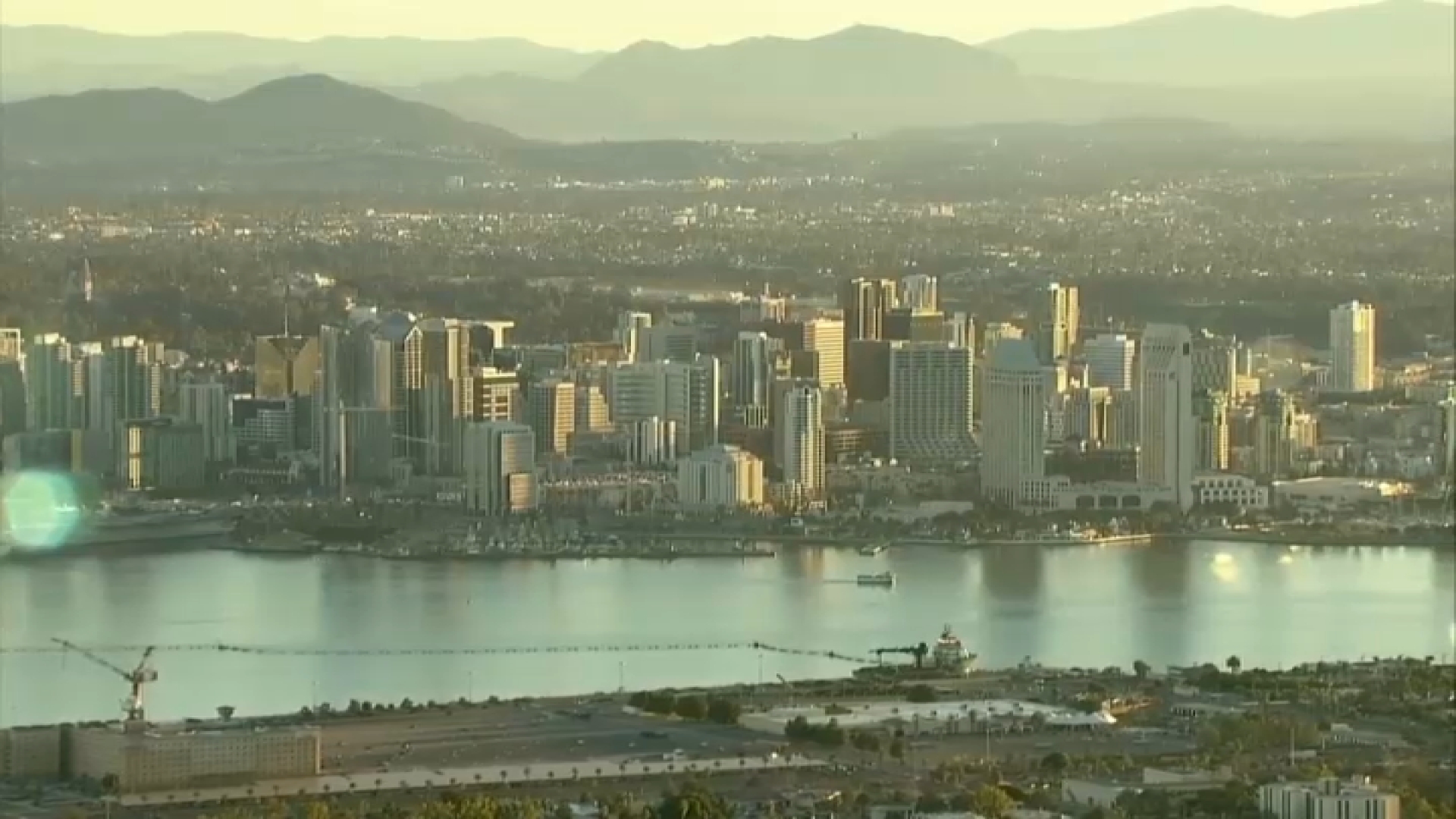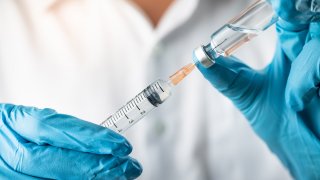
As California works through vaccinating its top priority group against Sars-COV-2, the disease that causes COVID-19, the question on many people's minds is: Who comes next and when will it be my turn?
Gov. Gavin Newsom on Monday, Dec. 28, provided some clarity on the next phases of the vaccine process when he revealed the recommendations made by the California's Community Vaccine Advisory Committee.
The committee is following the Center for Disease Control and Prevention's guidelines but expands upon them to ensure the vaccine is allocated equitably across the state, according to the California Department of Public Health.
When Could I Get the Vaccine?
Answer the questions to calculate your risk profile and see where you fall in your county's and state's vaccine lineup. This estimate is based on a combination of vaccine rollout recommendations from the CDC and the National Academies of Sciences, Engineering, and Medicine.
For a more detailed breakdown of who is included in each priority group, see this methodology.
Source: the Vaccine Allocation Planner for COVID-19 by Ariadne Labs and the Surgo Foundation
Interactive by Amy O’Kruk/NBC
On Jan. 7, 2021, in an effort to speed up vaccination efforts, the CDPH said local health departments and providers should begin administering vaccines to all people who fall under Phase 1A, instead of using a top-to-bottom approach, as previously recommended.
The state expects to be able to vaccinate most Californians by summer 2021. To be notified when it's your turn, sign up for notifications through the MyTurn website. This website will also allow eligible recipients find appointments when they become available.
On Jan. 13, 2021, Gov. Gavin Newsom confirmed the state would begin distributing vaccines to people 65 and older following new guidelines from the Trump administration to do so.
Local
The Department of Defense is distributing their own doses to military personnel in San Diego, following the same CDC guidelines the state is using.
Here's who is next, as of California's latest recommendations on Feb. 10, 2020 (This story will be updated as the state finalizes its vaccine priority list):
California's Vaccine Plan: Phase 1A -- Now Vaccinating
On Dec. 14, 2020, California hospitals began vaccinating people in priority group 1A, which includes critical care health care workers, long-term care faculty, and long-term care residents.
Phase 1A is broken down into three tiers, and vaccines were to be distributed in order from top to bottom. But on Jan. 7, the CDPH opened up vaccines to everyone in Phase 1A, regardless of tiers, in order to ramp up vaccination efforts. Then, on Jan. 13, the state opened up vaccinations to anyone 65 and older.
Anyone in the below three categories may now get vaccinated:
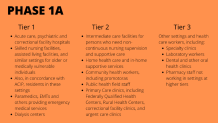
Phase 1A, Tier 1
- Acute care, psychiatric and correctional facility hospitals
- Skilled nursing facilities, assisted living facilities, and similar settings for older or medically vulnerable individuals
- Also, in concordance with ACIP, residents in these settings
- Paramedics, EMTs and others providing emergency medical services
- Dialysis centers
Phase 1A, Tier 2
- Intermediate care facilities for persons who need non-continuous nursing supervision and supportive care
- Home health care and in-home supportive services
- Community health workers, including promotoras
- Public health field staff
- Primary Care clinics, including Federally Qualified Health Centers, Rural Health Centers, correctional facility clinics, and urgent care clinics
Phase 1A, Tier 3
- Specialty clinics
- Laboratory workers
- Dental and other oral health clinics
- Pharmacy staff not working in settings at higher tiers
In San Diego County, about 635,000 health care professionals are now able to be vaccinated.
"We’re recommending to every one of them who fall in this group to contact their medical provider to schedule a vaccine, and if there's any issues where they can’t -- because their provider doesn’t have it or is not ready -- they can visit our website at vaccinationsuperstationsd.com," said County HHSA director Nick Macchione.
As part of the county's efforts to ramp up vaccinations, a cluster of tents was set up as a "Vaccination Super Station" near Petco Park. To visit, appointments must be made.
San Diego County Public Health Officer Dr. Wilma Wooten said there are 82,623 individuals in just the first bullet point of Phase 1A, Tier 1 and that the first round of COVID-19 doses -- from both Pfizer-BioNTech and Moderna -- would only cover about 72% of those individuals. So, there is a long way to go before the state reaches Phase 1B and Phase 1C.
Photos: Coronavirus Vaccine in San Diego
California's Vaccination Plan: Phase 1B -- Partially Vaccinating
California health officials have started to open up vaccine availability to some on Phase 1B, depending on the availability of vaccines. While the state has opened up the tiers eligible to be vaccinated, it is up the each county to determine if their is enough supply for all groups.
In this group, the Centers for Disease Control and Prevention recommends essential workers be vaccinated next. For California, the advisory committee suggests that group include high-risk individuals who are unable to work from home or those who work in high-impact geographic areas. This includes those who are most likely to spread the virus to co-workers or the public.
As of Feb. 10, the state is allowing vaccinations for anyone 65 years of age and older and those in the education and childcare sectors, emergency services sectors and food and agriculture sectors.
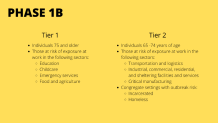
Phase 1B, Tier 1
- Those 75 years and older
- Those at risk of work exposure in the following sectors: education, childcare, emergency services, food and agriculture
Phase 1B, Tier 2
- Those 65 years to 74 years of age
- Workers in transportation and logistics; industrial, residential and commercial sectors; critical manufacturing
- incarcerated individuals and the homeless/unhoused
Phase 1B is expected to be finalized on Wednesday, Dec. 29.
California's Vaccination Allocation: Phase 1C
Who will get the vaccine in Phase 1C is still under consideration by California's advisory committee and is further away from being finalized.
The CDC recommends this phase to include adults with high-risk medical conditions and adults over 65, but California is considering many of these individuals in Phase 1B.
Instead, California's Phase 1C would continue the process of vaccinating people unable to work from home or those who work in high-impact geographic areas who are most likely to spread the virus to co-workers or the public.
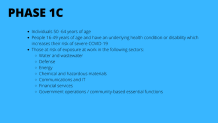
Phase 1C
- Those 50 to 64 years of age
- Those ages 16 to 49 with underlying medical conditions and disabilities
- Workers in water and waste management; defense; energy; chemical and hazardous; communications and IT; financial services and government ops/community service
CDC's Vaccine Allocation: Phase 2 and 3
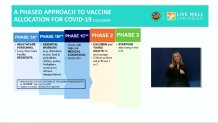
The state has not yet provided details on the rollout of the vaccine to the general public. The CDC recommends Phase 2 to include children and young adults 30 and younger and any remaining essential workers who were not vaccinated in earlier phases. Phase 3 would include everyone else.
The County said that the CDC estimates by June 2021, everyone who would like to get vaccinated against the novel coronavirus will be able to do so.
The Pfizer-BioNTech and the Moderna vaccine, which both have about a 95% effective rate, will be administered with two shots in the arm and may trigger side effects like fatigue, swelling, some pain, irritation or headache. Some patients who have taken the vaccine reported chills and low-grade fever, according to former FDA chief Dr. Margaret Hamburg.
Vaccine doses bought with U.S. taxpayer dollars will be free to Americans, according to the CDC. However, vaccination providers could charge an administration fee if they chose to.


